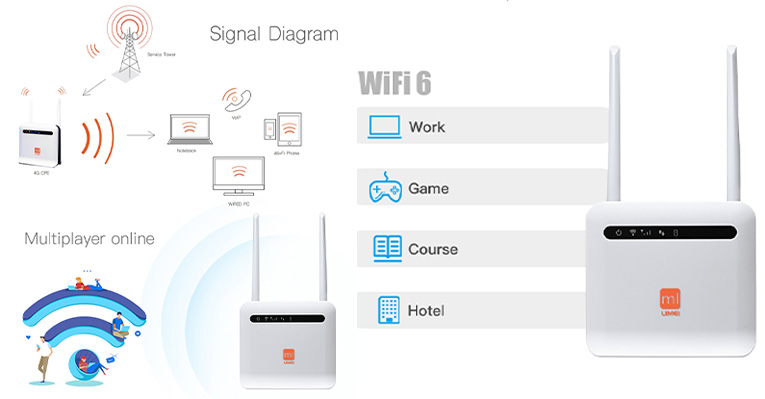Welcome: Shenzhen Limei Technology Co., Ltd
Email: szlimei@tddfdd.com
- TOP
- 13025463935
- Online
- WhatsApp code

In the modern era of connected devices and seamless internet access, a crucial component enabling wireless connectivity is 4G Wi-Fi CPE (Customer Premises Equipment) router. This scientific description aims to delve into the intricate workings and features of 4G Wi-Fi CPE router, shedding light on its fundamental aspects, technical capabilities, and its role in providing reliable and high-speed wireless internet access.

1. Wireless Communication and Network Architecture: 4G Wi-Fi CPE router acts as an intermediary between a user's local area network (LAN) and the cellular network infrastructure, enabling wireless communication. It utilizes the fourth-generation (4G) mobile network technology, which is designed to deliver faster data transfer rates, improved reliability, and enhanced network capacity compared to its predecessors.
2. Hardware Components: 4G Wi-Fi CPE router is composed of several essential hardware components. The primary elements include 4G cellular modem, a Wi-Fi access point, Ethernet ports, a processor, memory, and antennas. The 4G cellular modem enables the router to establish a connection with the cellular network, while the Wi-Fi access point facilitates wireless connectivity for local devices. Ethernet ports provide wired connectivity options, and the processor and memory handle the data processing and storage functions, respectively. Antennas play a crucial role in transmitting and receiving wireless signals.
3. Network Modes and Connectivity Options: 4G Wi-Fi CPE router supports various network modes, including 4G LTE (Long-Term Evolution), which is the prevalent standard for high-speed wireless data transmission. Additionally, it may support earlier 3G (Third Generation) and 2G (Second Generation) network technologies for backward compatibility. The router offers multiple connectivity options, such as Wi-Fi, Ethernet, and USB, allowing users to connect a wide range of devices and establish a reliable network.
4. Wireless Data Transmission and Security: The router employs advanced modulation and coding techniques to optimize wireless data transmission over the 4G network. It utilizes various frequency bands and channels to accommodate multiple users and minimize interference. Encryption protocols like WPA2 (Wi-Fi Protected Access 2) ensure secure wireless communication, protecting sensitive data from unauthorized access.
5. Advanced Features and Functionality: 4G Wi-Fi CPE router incorporates several advanced features to enhance user experience and network performance. These features may include Quality of Service (QoS) mechanisms to prioritize specific data types, such as video streaming or online gaming, for improved performance. Some routers support dual-band Wi-Fi, allowing simultaneous operation in the 2.4 GHz and 5 GHz frequency bands, providing better coverage and reduced interference. Additionally, the router may offer remote management capabilities, enabling users to control and monitor the network from a distance.
4G Wi-Fi CPE router serves as a vital component in enabling wireless connectivity and seamless internet access. By harnessing the power of 4G cellular technology, this device facilitates high-speed data transfer, reliable wireless communication, and multiple connectivity options. With its advanced features and functionality, 4G Wi-Fi CPE router continues to play a pivotal role in enabling the growing demand for connectivity in our increasingly connected world.
Contact: Sorho
Phone: +8613025463935
Email: szlimei@tddfdd.com
Add: 1006, 10th Floor, Shajing Yunhua Times Building, Shenzhen, Guangdong, China